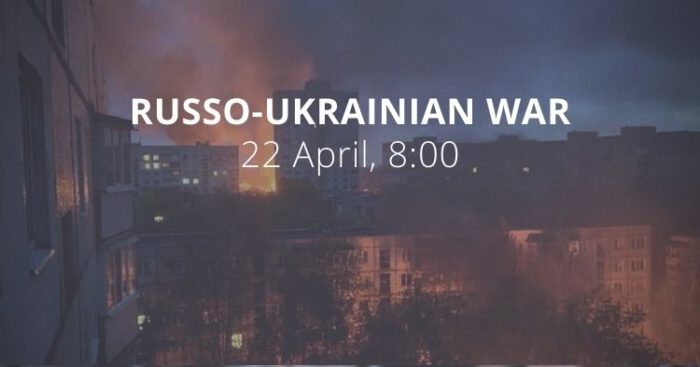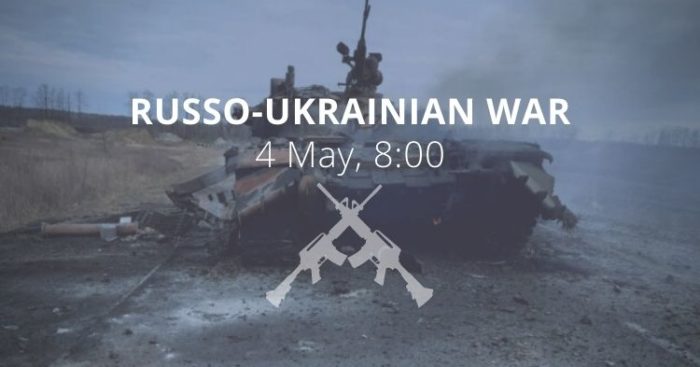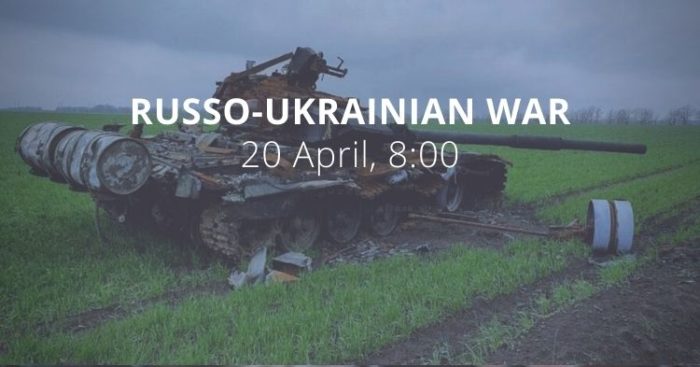Ukrainian counteroffensive around Kharkiv pushed Russian troops back within 10 kilometers of the border. Russian and Ukrainian forces battled for the Zmiinyi (Snake) Island. Russian troops carried out 34 airstrikes on the Azovstal Plant supported by artillery and tanks. 44 bodies were found under the rubble of an apartment building destroyed by occupiers in Izium.
Morning report day 77 – May 11
Situation
According to information from the General Staff as of 06.00 11.05.2022, supplemented by its 18:00 assessment.
The enemy does not cease offensive operations in the Eastern Operational Zone in order to establish full control over the territory of the Donetsk, Luhansk, and Kherson oblasts and maintain the land corridor between these territories and the occupied Crimea.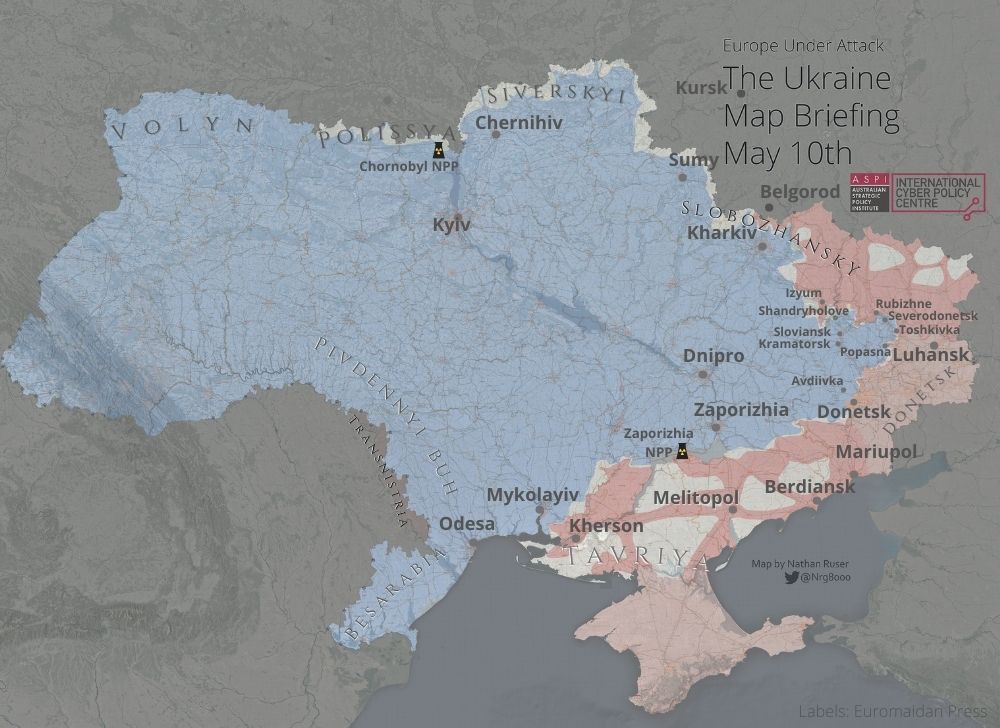
Russian forces are increasing the pace of strategic offensive operations in the Eastern Operational Zone. It exercises fire along the entire line of contact and in the depths of the defense of our troops. The greatest activity of the occupiers is observed in Slobozhansky and Donetsk directions.
The greatest activity of the occupiers is observed in Slobozhansky and Donetsk directions.
There is a high probability of missile strikes on civilian and military infrastructure.
In the Volyn, Polissya and Siversky directions, the situation will remain without significant changes.
- In the Volyn and Polissya directions, Russian forces did not take active action.
- In the Siversky direction, Russian forces continue to provide enhanced protection of the Ukrainian-Russian border in the Bryansk and Kursk oblasts. It fired mortars in the border areas near Karpovychi and Senkivka in the Chernihiv Oblast.
- There was a movement of military equipment of the Armed Forces of the Republic of Belarus as part of the combat readiness check and the completion of the rotation of individual units involved in strengthening the protection of the Ukrainian-Belarusian border in the Brest and Gomel oblasts.
In the Slobozhansky direction, the enemy operates in a group consisting of separate units of the 6th General Army of the Western Military District, the 41st General Army of the Central Military District, and the coastal troops of the Baltic and Northern Fleets. The occupiers continue to focus their efforts on preventing the further advance of our troops towards the state border of Ukraine, conducting reconnaissance units of the Defense Forces north and northeast of the city of Kharkiv.
- Russian forces did not conduct an active offensive. It continues to take measures to regroup existing units. It carries out engineering and fortification equipment of advanced positions, strengthens the air defense system, and increases the system of medical support.
- To prevent the advance of units of the Defense Forces of Ukraine and to strengthen its troops, the forces additionally moved to the territory of Kharkiv oblast up to five hundred mobilized persons from the temporarily occupied territory of Donetsk and Luhansk oblasts.
- In the Izium direction, a group of separate units of the 1st Tank Army and the 20th All-Military Army of the Western Military District, the 29th, 35th, 36th All-Military Armies and the 68th Army Corps of the Eastern Military District and Airborne Troops focus its main efforts on inflicting fire damage on our units in a certain area.
- In the Izium direction, Russian forces continued to create favourable conditions for the offensive, for which it replenished ammunition and logistics, conducted engineering equipment for advanced positions and strengthened air reconnaissance.
- As a result of coordinated actions of the personnel of the units of the Defense Forces of Ukraine in the Kharkiv Oblast, the settlements of Cherkasy Tyshky, Rusky Tyshky, Rubizhne and Bayrak were liberated.
In the Donetsk direction, the group of occupying troops is concentrating its main efforts on continuing the offensive to take full control of the city of Rubizhne and capture the settlements of Lyman and Sievierodonetsk.
- It does not stop assaults on the Lyman, Sievierodonetsk, Bakhmut, Avdiyev, and Kurakhiv areas with the support of artillery and jet artillery units.
- Russian forces carry out assault operations in the areas of the settlements of Nyzhne, Toshkivka, Orikhove, and Luhansk Oblast, has no success.
- In the city of Mariupol, the enemy is blocking our units near the Azovstal plant. With the support of artillery and tank fire conducts assault operations. Inflicts rocket and bomb strikes.
- Russian occupiers attempted assault operations in the directions of the town of Maryanka, the settlements of Kamyanka, Yasynuvata district, and Novomykhailivka, Pokrovsky district, Donetsk oblast. They were unsuccessful.
- Russian forces are trying to gain a foothold in the area of the settlement of Oleksandrivka, are carrying out assault operations in the area of the settlement of Shandryholove, Donetsk Oblast, has no success.
- In the city of Mariupol, Russian forces continue to focus their efforts on blocking and destroying our units in the area of the Azovstal plant. With the support of artillery and tank fire, it conducts assault operations.
- In the Donetsk and Luhansk oblasts, defenders of Ukraine repulsed twelve enemy attacks, destroyed twelve tanks, four artillery systems, nineteen units of armored combat vehicles, seven cars and two units of special engineering equipment of the enemy but the overall numbers are higher – see below.
- In the Pivdenny Buh and Tavriya directions, Russian units are trying to improve their tactical position.
- In the Mykolaiv direction, the enemy continues to carry out attacks on the position of defenders of Ukraine.
- The enemy uses electronic warfare systems to suppress radio channels.
- In the Kryvyi Rih direction, he fired on artillery units of our troops.
- In order to consolidate the occupied territory, it carries out engineering works and creates new positions in the areas of the settlements of Bruskinske and Velyka Oleksandrivka.
- In the Tavriya direction, it conducts demonstration actions in order to restrain the actions of units of the Defense Forces, improve the engineering equipment of its positions, and replenishes its reserves.
- In the Bessarabian direction, the situation in the Transnistrian region of the Republic of Moldova remains tense. Units of the task force of the Russian troops continue to be in "Full" combat readiness.
- An intensified level of terrorist threat continues to operate in the Transnistrian region of the Republic of Moldova. Mobilization activities are not being carried out in the region, and local armed groups and a task force of Russian troops continue to be on high alert.
The enemy continues to destroy Ukraine's civilian infrastructure by launching missile and bomb strikes and carrying out artillery shelling of settlements and infrastructure. The constant shelling by Russian troops does not allow for a full-fledged evacuation of civilians and wounded from the war zone.
During the previous day, the air defense units of the Air Force and the Land Forces hit four UAVs of the Orlan-10 type. In addition, one of the brigades of the assault troops of the Armed Forces of Ukraine destroyed one Mi-24 helicopter.
The Ukrainian air force in certain directions continues to engage the enemy from the air and to support the fighting of our troops.
Russian forces continue to suffer losses
on the territory of Ukraine. Thus, according to available information, units of the 138th separate mechanized brigade of the 6th Combined Arms Army of the Western Military District due to significant losses in the Kharkiv Oblast were withdrawn from Ukraine to the Belgorod Oblast of the Russian Federation. A significant part of the remaining military personnel under the contract wrote reports on dismissal.”
Belarus to deploy special forces to the southern border near Ukraine, the Reuters reports. Belarus will deploy special operations troops in three areas near its southern border with Ukraine, the armed forces said on Tuesday.
President Zelenskyy: Russia has launched 2,154 missile strikes on Ukraine, the Ukrinform reports.
“Just think of this terrible figure: 2154 Russian missiles hit our cities and communities in a little over two months. 2770 appearances of enemy planes in our sky were recorded. The Russian bombing of Ukraine does not cease any day or night. … In two days, on May 8 and 9, when Europeans honoured the memory of the victims of World War II and celebrated Europe Day, the Russian army launched 25 missiles targeting Odesa and the Odesa Oblast alone. All 25 missiles were aimed at civilian objects, Zelenskyy told.” The relevant statement was made by Ukrainian President Volodymyr Zelenskyy during his speech in the Parliament of Malta.”
On May 10 Ukrainian Armed Forces (UAF) have destroyed:
- up to 260 Russian invaders, 4 tanks, 2 armored personnel carriers, 2 infantry fighting vehicles, 4 self-propelled artillery vehicles, 72 motor vehicles and 2 unmanned aerial vehicles (UAV) in the Eastern Operational Area (Kharkiv, Donetsk, Luhansk, Dnipropetrovsk and Zaporizhzhia Oblasts). Russian troops launched 4 attacks in eastern Ukraine presumably outside the JFO area.
- 12 enemy tanks, four artillery systems, 12 armored fighting vehicles, two special engineering vehicles, seven motor vehicles, 1 Mi-24 helicopter and 3 Orlan-10 UAVs in the Joint Forces Operations (JFO) Area (Luhansk and Donetsk). JFO successfully repelled 12 enemy attacks.
- 79 servicemen and 12 units of equipment, including 2 UAVs, such as Orlan-10 UAVs, as well as howitzers, trucks, and armored vehicles in the Southern Operational Area (Vinnytsia, Kirovograd, Odesa, Mykolaiv and Kherson Oblast).
Azovstal assault: Russians carry out 34 airstrikes in one day, the Ukrinform reported Tuesday afternoon. The Russian invaders performed 34 airstrikes, including eight sorties by strategic bombers, at the Azovstal steelworks in the besieged city of Mariupol, Donetsk Oblast, over the past day. The forces continue to storm the Ukrainian stronghold. This was claimed by the Mariupol City Council’s post on Telegram.
Ukrainian defenders sing at the Azovstal steelworks in Mariupol as Russia continues to shell and bomb the factory. They say they will fight to the end
The frontwoman of this band is Kateryna "Ptashka" ("bird"), who left for the army after completing music studies
📷Nik Mark pic.twitter.com/bakhnZ7X6P
— Euromaidan Press (@EuromaidanPress) May 11, 2022
Ukrainian soldiers have already liberated more than 1,000 villages and towns, 224 demined, the Ukrainska Pravda reports. Deputy Head of the Presidential Office Kyrylo Tymoshenko announced what has been achieved in terms of the restoration of critical infrastructure in the occupied cities and towns.
“Currently there are 1003 settlements where this has been successful. 224 of these have already been demined. The National Police has resumed work in almost 600 de-occupied towns and villages. 83% of local governments are back to work. 70% of the roads in the unoccupied territories and 42% of the rail network are now usable again. Gas supplies have been restored to 650 settlements. 83% of settlements have electricity. 60% of settlements have water supply and sewerage.”
According to British Defense Intelligence, (last 24 hours):
- Fighting continues at Zmiinyi Island, also known as Zmiinyi (Snake) Island, with Russia repeatedly trying to reinforce its exposed garrison located there.
- Ukraine has successfully struck Russian air defenses and resupply vessels with Bayraktar drones. Russia’s resupply vessels have minimum protection in the western Black Sea, following the Russian Navy’s retreat to Crimea after the loss of the Moskva.
- Russia’s current efforts to augment its forces on Zmiinyi Island offer Ukraine more opportunities to engage Russian troops and attrit materiel. If Russia consolidates its position on Zmiinyi Island with strategic air defense and coastal defense cruise missiles, they could dominate the north-western Black Sea.
As of Wednesday 11 May, the approximate losses of weapons and military equipment of the Russian Armed Forces from the beginning of the war to the present day: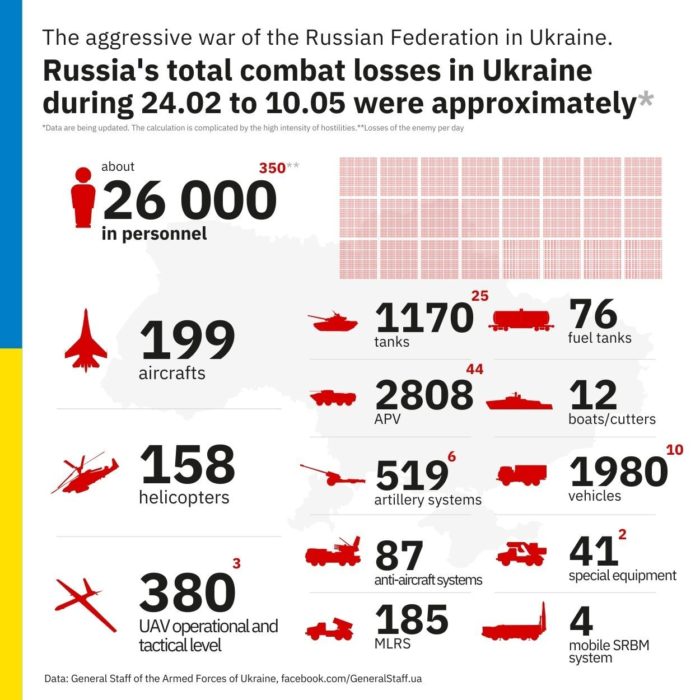
- Personnel – more than 26350 people (+350),
- Tanks – 1187 units (+17),
- Armored combat vehicles – 2856 units (+48),
- Artillery systems – 528 (+9),
- Multiple rocket launchers – 185 (+0)
- Air defense means – 87 (+0),
- Aircraft - 199 (+0),
- Helicopters - 160 (+2),
- Automotive technology and fuel tanks – 1997 (+17),
- Vessels/boats - 12 units (+1),
- UAV operational and tactical level – 390 (+10)
- Special equipment – 41 (+0)
- Mobile SRBM system – 4 (+0)
- Cruise missiles – 94 (+0)
Russian enemy suffered the greatest losses (on the last day) at the Novopavlivsk, Kurakhiv and Sievierodonetsk directions.
Humanitarian
Azov regiment posted pictures of injured defenders of Mariupol on their telegram channel as of May 10 afternoon:
“The entire civilized world has to act and see the conditions in which the injured and crippled defenders of Mariupol are staying now! In total unsanitary, with open wounds, bandaged with non-sterile bandages, without the necessary medication and even food. We are calling the UN and ICRC to show their humanity and reaffirm their core values based on which these institutions were created, and do so by saving injured people, who are not in their capacity as combatants anymore.
Troops whom you see in these photos, and hundreds of others on Azovstal with severe wounds, by the cost of their health, defended Ukraine and the entire civilized world. Are Ukraine and the world community unable to protect them now?
We are demanding an urgent evacuation of injured troops to Ukraine-controlled territories, where they would get the care and adequate support.”
https://twitter.com/EuromaidanPress/status/1524293886939643904?s=20&t=weh-FvmHkQk4o4Do0AkZ1Q
According to UNHCR 5,917,703 refugees have been registered as of May 9. The UN says that so far Poland has taken in 3,234,036 refugees, Romania 883,655, Russian Federation 739,418, Hungary 572,760, Republic of Moldova 457,066, Slovakia 404,463 and Belarus 26,985. Among those who fled Ukraine are also Ukrainian nationals with dual citizenship. An additional 105,000 people moved to the Russian Federation from the Donetsk and Luhansk oblasts between 18 and 23 February.
The number of Ukrainians entering Ukraine since February 28 is 1,560,500 as of May 9. This figure reflects cross-border movements, which can be pendular, and does not necessarily indicate sustainable returns.
OHCHR recorded 7,172 civilian casualties in Ukraine as of May 9. 3,459 were killed (including 238 children) and 3,713 injured (including 347 children).
Legal
44 bodies were found under the rubble of an apartment building destroyed by occupiers in Izium, the Ukrainska Pravda reports.
"The bodies of 44 dead civilians have been found in the temporarily occupied city of Izium under the rubble of a five-story building which the occupiers destroyed in the first ten days of March, the Head of the Kharkiv Oblast Military Administration, Oleh Syniehubov, said. "This isn’t the only building like this, unfortunately, but there is no special equipment for sorting out the rubble, so everything is done manually, and usually it’s not done around the clock, but only when there is no shelling going on."
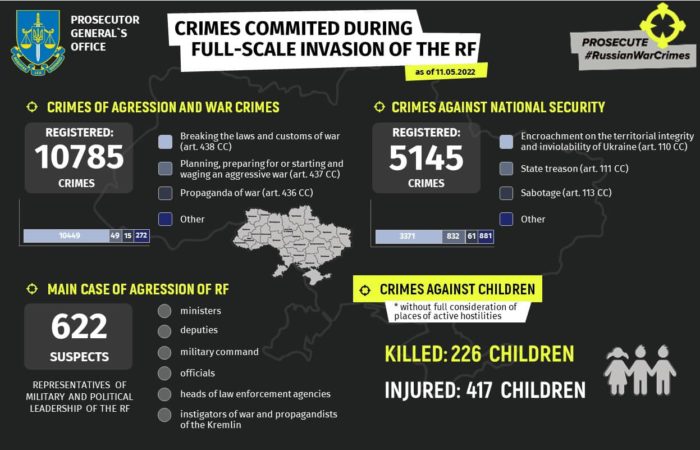 Germany to provide full support to Ukraine in solving Russia's war crimes – Baerbock, the Ukrinform reports. "We will gather evidence as an international community. I have assured Ukrainian Prosecutor General Iryna Venediktova of Germany's full support in solving the war crimes: politically, financially and in terms of personnel," the German Foreign Minister, Annalena Baerbock, wrote on her Twitter account.
Germany to provide full support to Ukraine in solving Russia's war crimes – Baerbock, the Ukrinform reports. "We will gather evidence as an international community. I have assured Ukrainian Prosecutor General Iryna Venediktova of Germany's full support in solving the war crimes: politically, financially and in terms of personnel," the German Foreign Minister, Annalena Baerbock, wrote on her Twitter account.
Russia was behind cyberattack in run-up to Ukraine war, investigation finds, The New York Times reports.
The attack was focused on a system run by Viasat
, a California company that provides high-speed satellite communication services — and was used heavily by the Ukrainian government. The attack came a few weeks after some Ukrainian government websites were hit with “wiper” software that destroys data.
The Viasat attack appeared intended to disrupt Ukraine’s command and control of its troops during the critical first hours of Russia’s invasion, American and European officials said. The hack also disconnected thousands of civilians in Ukraine and across Europe from the internet. It even thwarted the operation of thousands of wind turbines in Germany that relied on Viasat’s technology for monitoring conditions and controlling the turbine network.”
226 children were killed, and 417 children injured, the Office of the Prosecutor General of Ukraine reports as of May 11. 1,657 educational establishments are damaged as a result of shelling and bombings, 139 of them are destroyed fully. 10,785 crimes of aggression and war crimes and 5,145 crimes against national security were registered.
Meanwhile, in Ukraine - Timur Miroshnychenko, the Ukrainian voice of @Eurovision for over 15 years, comments on the first semifinal of the song contest from a bomb shelter in Kyiv
🇺🇦Kalush Orchestra's "Stefania" is slated to win Eurovision 2022, bookmakers say
📷 @Ukrinform_News pic.twitter.com/ogEQa1WXhV— Euromaidan Press (@EuromaidanPress) May 10, 2022
Support
US sending Ukraine electronic jamming gear in $150M package, the C4ISRnet reports.
“The US is sending electronic jamming equipment to the front lines in Ukraine. The Defense Department on May 6 said a $150 million security package bound for Eastern Europe includes the jamming gear, as well as 25,000 artillery rounds, radar systems, and other field equipment and spares. The Pentagon would not comment publicly on specific details about the electronic warfare kit, which Ukrainian forces requested as Russia continues its offensive in the east part of the country. A senior defense official said Monday it was the first time the US gave EW equipment to Ukraine since Russia’s invasion began Feb. 24.”
US House passes a $40 bln bill to bolster Ukraine against Russian invasion, the Reuters reports.
“The US House of Representatives approved more than $40 billion more aid for Ukraine on Tuesday, as Congress races to keep military aid flowing and boost the government in Kyiv as it grapples with the Russian invasion.
The package includes $6 billion for security assistance, including training, equipment, weapons, and support; $8.7 billion to replenish stocks of US equipment sent to Ukraine, and $3.9 billion for European Command operations. In addition, the legislation authorizes a further $11 billion in the Presidential Drawdown Authority, which allows the president to authorize the transfer of articles and services from US stocks without congressional approval in response to an emergency. It also authorizes $4 billion in Foreign Military Financing to provide support for Ukraine and other countries affected by the crisis. The new aid package also includes humanitarian assistance - $5 billion to address food insecurity globally due to the conflict and nearly $9 billion for an economic support fund for Ukraine.”
New developments
1. On possible nuclear strike, Russia says: it's all in our military doctrine, the Reuters reports.
“Asked if Russia would rule out a pre-emptive tactical nuclear strike on Ukraine, Russia's deputy foreign minister said on Tuesday that a decision on the possible use of nuclear weapons was clearly set out in Russia's military doctrine, RIA reported. We have a military doctrine - everything is written there, Alexander Grushko was quoted by state news agency RIA as saying. Russia's official military deployment principles allow for the use of nuclear weapons if they - or other types of weapons of mass destruction - are used against it, or if the Russian state faces an existential threat from conventional weapons”.
2. Kuleba: We have not seen a strong position from NATO since the start of the war, the Ukrinform reports.
"I do not have high expectations from this meeting at the moment, because since the beginning of the war we have seen a very active role of individual NATO members or the groups they form, but we have not seen an active and strong position of the alliance as an organization, Kuleba said. He also said that he had not yet received an invitation to the informal summit of NATO foreign ministers in Berlin but would attend if he did.
In principle, it seems strange to me to discuss in NATO any security issues in the Euro-Atlantic area without Ukraine, given the objective situation. Kuleba also stressed that the future of Europe and the Euro-Atlantic area is being decided on the Ukrainian fronts. The North Atlantic Council is expected to hold an informal meeting at the level of foreign ministers in Berlin on May 14-15”.
3. World Health Organization members pass a resolution against Russia, the Reuters reports.
“Members of the World Health Organization's European region passed a resolution on Tuesday that could result in the closure of Russia's regional office and the suspension of meetings in the country in response to its invasion of Ukraine”.
4. Finnish Parliament's defense committee recommends NATO membership, the Reuters reported.
“Joining NATO is the best option for Finland to guarantee its national security, the Finnish Parliament's defense committee said on Tuesday, ahead of Finland's official decision on whether or not to join the Western defense union in the coming days.” Finland's NATO membership would significantly increase the deterrent for becoming a target of Russia's aggression, the committee concluded in a statement.
5. Baerbock: Germany insists on Ukraine's full-fledged EU membership, the Ukrinform reports. "We insist on Ukraine's full-fledged membership in the European Union," Minister of Foreign Affairs of Germany Annalena Baerbock said. "We will find a way for Ukraine's participation in the European Union, and we will confirm that Ukraine belongs to the European Union," the German minister stressed.
6. Zelenskyy met German and Dutch foreign ministers, the Ukrinform reports. "A meaningful meeting with German Foreign Minister Annalena Baerbock and Dutch Foreign Minister Wopke Hoekstra. Support from your countries is important and valuable for us. Thank you for standing in solidarity with the Ukrainian people today," Zelenskyy wrote on Telegram.
Assessment
On the War
The Institute for the Study of War has made the following assessment as of Tuesday 10 May:
The Ukrainian counteroffensive will likely continue to divert Russian troops and resources from deployment to other axes of advance where fighting has been similarly stalled out by the successful Ukrainian defense. The counteroffensive will impede the ability of Russian artillery to target the northeastern suburbs of Kharkiv City, will potentially enable Ukrainian forces to threaten Russian rear areas with their own shelling and further attacks, and—if Ukrainian forces are able to further advance the counteroffensive or Russian forces collapse along the Kharkiv axis and withdraw further—unhinge Russian offensive operations around Izium. The Belarusian Ministry of Defense escalated its false claims of US and NATO preparations to attack Belarus while announcing the start of a second stage of ongoing military exercises on May 10. However, Belarus remains unlikely to join the war in Ukraine. Belarusian Defense Minister Viktor Khrenin announced the second stage of ongoing rapid response forces exercises on May 10 in response to what he falsely claimed were NATO escalations. Belarusian First Deputy Minister of Defense Victor Gulevich accused the US and its allies of building up a military presence around Belarusian borders and claimed that Poland and the Baltic states are threatening Belarusian territory through reconnaissance, sabotage, and special operations. Gulevich announced that Belarusian battalion tactical groups (BTGs) will subsequently advance to the Western and Northwestern operational zones as part of a ”whole range of measures aimed at countering possible threats” in these areas. Gulevich additionally stated that the presence of 20,000 Ukrainian troops in Belarus’ Southern Operational District has necessitated the deployment of unspecified Belarusian troops to three tactical directions near the Ukrainian border, which is consistent with Ukrainian General Staff reporting that certain Belarusian units have deployed to the Ukraine-Belarus border area for a combat readiness check. The rhetoric of threats to Belarus’ borders is not new and was frequently employed by Belarusian President Aliaksandr Lukashenka in the early stages of the Russian invasion of Ukraine. The Belarusian exercises, which are concentrated on Belarus’ borders with Poland and the Baltic States rather than Ukraine, are likely primarily demonstrative and signal Belarus’ continued political support for Russia‘s war in Ukraine. The exercises are likely additionally intended to draw NATO attention and possibly disrupt NATO aid to Ukraine, rather than threatening an actual military operation—similar to Russian efforts to destabilize Moldova that are likely intended to distract Romania and NATO rather than directly threaten Odesa. Belarus remains unlikely to join the war in Ukraine. Lukashenka successfully repressed domestic opposition in 2020 and 2021 but remains vulnerable to further domestic unrest if his security apparatus weakens; he is likely unwilling to risk losing his military in a stalled and deteriorating Russian war in Ukraine. Key Takeaways Russia suffers catastrophic losses in the war and changes its propaganda – Ukrainian intelligence, the Ukrainska Pravda reports. "Despite having numerous advantages in manpower and equipment, the army of the occupying country is suffering catastrophic losses and defeats from the defenders of Ukraine. In order to change the perception of Russians about the military’s ‘invincibility’ and prepare the society for a possible defeat, the Russian media were ordered to talk about the Russian-Ukrainian war as an armed confrontation between the Russian Federation and all the countries of the European Union and NATO, the Defense Intelligence of Ukraine (DIU) reports. According to Kremlin political strategists, this will lessen the shame of losing to a more powerful adversary." According to DIU, the heads of the Kremlin TV channels, Internet media and the pro-Putin army of bots are already being instructed to move to a new information policy. Russia's invasion of Ukraine at "bit of a stalemate" - US intel official, the Reuters reports. Russia's three-month-long war in Ukraine is at a "bit of a stalemate" and Russian President Vladimir Putin appears to be preparing for a long conflict, top US intelligence officials said on Tuesday. Russia's war has killed thousands of civilians, sent millions of Ukrainians fleeing and reduced cities to rubble. Moscow has little to show for it beyond a strip of territory in the south and marginal gains in the east. … During the same hearing, Director of National Intelligence Avril Haines said that a Russian victory in the Donbas region in eastern Ukraine might not end the war. "We assess President Putin is preparing for a prolonged conflict in Ukraine during which he still intends to achieve goals beyond the Donbas," Haines told lawmakers. She added that Putin was counting on the Western resolve to weaken over time and as the conflict continued, there was concern about how it would develop in the coming months. "Combined with the reality that Putin faces a mismatch between his ambitions and Russia's current conventional military capabilities ... the next few months could see us moving along a more unpredictable and potentially escalatory trajectory," Haines said. … Asked about the prospect of Putin using tactical nuclear weapons, Berrier said: "Right now, we do not see that." Haines said earlier that the intelligence community believes Putin would authorize the use of nuclear weapons only if he perceived an existential threat to the Russian state.” Consequences and what to do? Ukraine War’s Geographic Reality: Russia Has Seized Much of the East, The New York Times reports. “Russia’s nearly three-month-old invasion of neighboring Ukraine has been punctuated by flawed planning, poor intelligence, barbarity, and wanton destruction. But obscured in the daily fighting is the geographic reality that Russia has made gains on the ground. The ministry’s assertion, if confirmed, strengthens the prospect that Russia could soon gain complete control over the region, known as the Donbas, compared with just a third of it before the Feb. 24 invasion. That is a far cry from what appeared to be the grand ambitions of President Vladimir V. Putin of Russia when he launched the invasion: quick and easy seizure of vast swaths of Ukraine, including the capital, Kyiv, the overthrow of a hostile government, and a replacement with unquestioned fealty that would ensure Ukraine’s subservience. Nonetheless, the Donbas seizure, combined with the Russian invasion’s early success in seizing parts of southern Ukraine adjoining the Crimean Peninsula, which Russia illegally annexed in 2014, gives the Kremlin enormous leverage in any future negotiation to halt the conflict. And the Russians enjoy the added advantage of naval dominance in the Black Sea, the only maritime route for Ukrainian trade, which they have paralyzed with an embargo that could eventually starve Ukraine economically and is already contributing to a global grain shortage. Testifying before the Senate Armed Services Committee in Washington on Tuesday, Avril D. Haines, the director of national intelligence, warned of a “prolonged conflict” in Ukraine as Russia seeks expansive territorial gains beyond the Donbas region, including the creation of a land bridge across Ukraine’s Black Sea coast. …” “The Donbas seizure, combined with the Russian invasion’s early success in seizing parts of southern Ukraine adjoining the Crimean Peninsula gives the Kremlin enormous leverage in any future negotiation to halt the conflict”, The New York Times very rightfully assesses. The analysis also refers to the US national intelligence warning of a “prolonged conflict” in Ukraine as Russia seeks expansive territorial gains beyond the Donbas region. The two reflect Russia’s “Donbas strategy 2014-22”. It occupied parts of Donbas, established so-called “People’s Republics”, and started negotiations to create the resemblance of hope for a peaceful solution to the conflict to ensure that the West remained disengaged. It also allowed Russia to uphold its attempt to undermine Ukraine from within through the parallel and synchronized use of both military and non-military means for 8 years. They succeeded big time, as neither the USA nor Europe provided defense aid of substance which would help Ukraine build deterrence. More importantly, while the West was hoping for a peaceful resolution, Russia used the 8 years to prepare for the 24 February 2022 invasion. The military build-up the US Intelligence started reporting at the end of November last year, started in 2014, and continued until the last phase of the war started. A major bulk of the forces fighting in Ukraine are after all from the neighboring Russian military districts and the bases that over the last 8 years have been relocated closer to the Ukrainian borders. Additionally, the UN passed resolutions on the “Problem of the militarization of the Autonomous Republic of Crimea and the city of Sevastopol, Ukraine, as well as parts of the Black Sea and the Sea of Azov” in both 2018, 2019, 2020, and 2021. The build-up was known to the international community for years already. The escalation reported by the intelligence community this winter was only the reinforcements from the Northfleet, Central, and Eastern Military Districts. After 8 years of hybrid war, including a low-intensity war in Donbas, the expectation of a prolonged war of attrition should not come as a surprise to anyone. It is, after all, only a continuation of a strategy that has existed for 8 years already. The strategy builds on the Hybrid War concept that involves the parallel and synchronized use of both military and non-military means to destabilize and destroy the nation from within. Until 24 February, Russia was controlling approximately 19.6% (145 000 km2) of Ukrainian territory and maritime areas under its jurisdiction. This included the Ukraine’s Autonomous Republic of Crimea, the city of Sevastopol, the adjacent Maritime Exclusive Economic Zones, and certain areas of Donetsk and Luhansk oblasts. If Russia manages to establish control over all of Luhansk, Donetsk, Zaporizhzhia, and Kherson oblast – and recognizing that they already control all of Ukraine’s Maritime Exclusive Economic Zones – it will control nearly 248 000 km2 (33,5%) of Ukrainian territory and areas under its jurisdiction. This will provide Russia with a great “launchpad” for its next attempt to establish control over all of Ukraine. More importantly, it will have succeeded in cutting Ukraine’s access to the sea and has, thereby, denied Ukraine the economic foundation to function as an independent state. It not only stops all imports and export, but also controls its energy resources in Donbas, the Sea of Azov, and the Black Sea. This is meant to give substance to my arguments on “What constitutes a victory?” and what is needed to help Ukraine achieve it? I have previously attempted to describe what a victory probably needs to look like to secure a sovereign and independent Ukraine. In the article Collective Defense or Collective Denial? I argue that the West does not have a sustainable strategy to help secure a Ukrainian win and a Russian defeat. The military asymmetry between the two is too big to bridge for Ukraine to achieve this on its own. The global ripple effects and the human suffering are too massive for the international community to wait for the two parties to “fight it out”. “NATO must become an active party to the war and help defend Ukraine from the Russian threat from both land, sea, air, and cyber. The Alliance – or a Coalition of the Willing - must deploy maritime forces to the Black Sea and start enforcing a No-Fly Zone over Ukraine. Ukraine has proven itself more than capable of fighting the war on the ground but needs the West to fill its critical vulnerabilities and provide the joint enablers.“ The international community cannot allow Russia to remain on any part of the Ukrainian territory if we want to both ensure a Ukrainian victory and deny Russia the opportunity to continue its war against Ukraine and the West at a later stage.
Assessement by Hans Petter Midttun


